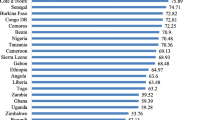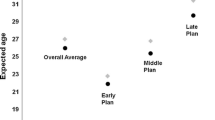Abstract
Attitudes toward childbearing and desired family size influence women's reproductive choices. This may be especially true in the Latina culture, where motherhood and large families are valued highly. To determine whether these attitudes differ by educational status, Latina women in an OB/GYN clinic (N=351) completed a survey assessing attitudes toward childbearing and desired family size. Attitudes of women with and without a high school education were compared. Respondents without a high school education desired a mean of 3.1 children, while those with a high school education desired a mean of 2.7. Women without a high school education endorsed more attitudes favoring large families. Among women without a high school education, those who wished to have a son to carry on the family name tended to desire larger families. Results suggest that the desire for large families among Latina women with low education may result from traditional cultural attitudes.
Similar content being viewed by others
REFERENCES
Castro, M.T. (1995). Women's education and fertility: Results from 26 Demographic and Health Surveys. Studies in Family Planning, 26, 187-202.
Garza-Chapa, R., Jiménez-Contreras, J.A., Riojas-Valdés, V.A., & Cerda-Flores, R.M. (1989). Preferences on family composition among youngsters from Monterrey, Mexico. Salud Publica Mexico, 31, 32-45.
Giachello, A.L.M. (1994). Maternal/perinatal health. In C.W. Molina, & M. Aguirre-Molina (Eds.) Latino Health in the US: A Growing Challenge. Washington, D.C: American Public Health Association.
Jensen, E. (1985). Desired fertility, the "up to God" response, and sample selection bias. Demography, 22, 445-54.
Landale, N.S., & Hauan, S.M. (Nov. 1996). Migration and premarital childbearing among Puerto Rican women. Demography, 33, 429-42.
Parker, R.M., Williams, M.V., Baker, D.W., & Nurss, J.R. (1996). Literacy and contraception: Exploring the link. Obstetrics and Gynecology, 88, 72S-77S.
Ryan, I.J., & Dunn, P.C. (1988). Association of race, sex, religion, family size, and desired number of children on college students' preferred methods of dealing with unplanned pregnancy. Family Practice Research Journal, 7, 153-61.
Smith, P.B., & Weinman, M.L. (1995). Cultural implications for public health policy for pregnant Hispanic adolescents. Health Values, 19, 3-9.
Unger, J.B., & Molina, G.B. (1997). Desired family size and son preference among Mexican-American women of low socioeconomic status. Family Planning Perspectives, 29, 284-287.
Author information
Authors and Affiliations
Rights and permissions
About this article
Cite this article
Unger, J.B., Molina, G.B. Educational Differences in Desired Family Size and Attitudes Toward Childbearing in Latina Women. Population and Environment 20, 343–351 (1999). https://doi.org/10.1023/A:1023301627258
Issue Date:
DOI: https://doi.org/10.1023/A:1023301627258




